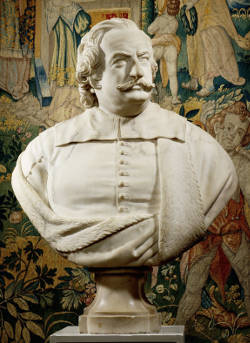Although the Dissius auction catalogue of 1696 documents unequivocally that Jacob Abrahamsz. Dissius (1653–1695) was the owner of twenty-one Vermeer paintings upon his death, there had been much speculation as to how he had actually assembled his extraordinary collection. The scholar John Michael Montias built a very suggestive case using existing archival evidence coupled with a profound knowledge of Vermeer's social and artistic milieu.
Dissius was baptised on 23 November 1653 in Delft as the son of Maria Cloeting and the printer Abraham Dissius. Jacob married Magdalena Pieters van Ruijven, born in 1655, on 14 April 1680, and was generally known after that by her husband's surname. Her parents were Pieter van Ruijven (1624–1674) and Maria de Knuijt (c. 1623–1681), patrons of Vermeer for the better part of the artist's career. According to Montias, the bulk of the Dissius collection came from the art collection of Van Ruijven who had likely bought the paintings directly from Vermeer, and De Knuijt, who we know beleive must have palyed an euqally imprtant, if not dominant, role in the formation of the couple's art collection The paintings in Van Ruijven/De Knuijt collection were then bequeathed to his daughter, Magdalena, who married Dissius in 1680, after the death of De Knuijt.
Dissius and his wife Magdalena may have acquired other paintings on their own behalf., although it is possilbe they were acquited by De Knuijt after her husband's death. Montias also sees evidence that the relationship between his principal patrons and Vermeer went far beyond that of client and artist. Van Ruijven witnessed the will of Vermeer's sister Gertruij in her own house shortly before her death. But most importantly, in 1665, Vermeer was bequeathed the sum of 500 guilders by De Knuijt in her will. This kind of third-person bequest was extremely unusual, if not unique.

François Dieussart
c. 1645–1650
Marble, h 89 x w 65.0 x d 32 cm.
Rijksmuseum, Amsterdam
Furthermore, Montias argues that "artists such as Vermeer would have only invested the time necessary to paint refined, meticulous rendered genre scenes for specific patrons rather than for the open market."John Michael Montias, Vermeer and His Milieu: A Web of Social History (Princeton, NJ: Princeton University Press, 1989), 22.
Van Ruijven may have wished to fashion himself as a patron of the arts similar his relative Pieter Spiering Silvercroon (1591–1652). Silvercroon was a patron of Gerrit Dou (1613–1675), "one of the best remunerated painters of the century. SIlvercroon had an arrangement to pay Dou the sum of 500 guilders a year for the right of first refusal on this sought-after master's work (whose subjects were mostly modern). Phillp Angel, in his Praise of Painting of 1642, writes of Spiering's arrangement with Dou. In his account, within the ranks of such fabled patrons of antiquity and the Renaissance as King Attalus, Alexander, Caesra, the Emperor Maximilia, Julius II and Francis I, the only Dutchman named is Spiering. By emulating him, Van Ruijven hoped to improve his social luster by linking his name to that of an outstanding local talent—Vermeer—and more generally, by assembling a choice art collection." Luisa Vergara, "Perspectives on Woman in the Art of Vermeer," in The Cambridge Companion to Vermeer, ed. Wayne A. Franits (Cambridge: Cambridge University Press, 2001), 69.
However, both Ben Broos Ben Broos, "Un célèbre Piejntre nommé Verme(e)r," in Johannes Vermeer, exh. cat., eds. Arthur K. Wheelock Jr. and Ben Broos (London and New Haven: Yale University Press, 1995).and Arthur K. Wheelock Jr. Arthur K. Wheelock Jr., "Vermeer and Delft: His Life and Artistry," in Johannes Vermeer, exh. cat., eds. Arthur K. Wheelock Jr. and Ben Broos (London and New Haven: Yale University Press, 1995). maintain that even though Van Ruijven may have indeed been one of Vermeer's clients, it remains uncertain if he was Vermeer's principal patron. Wheelock argues that "the hypotheses that Van Ruijven was Vermeer's patron, although appealing, should be cautiously approached, for no document specifies that Vermeer ever painted for Van Ruijven. Moreover, no source confirms that Van Ruijven himself had any Vermeer paintings in his possessions." Arthur K. Wheelock Jr., "Vermeer and Delft: His Life and Artistry," in Johannes Vermeer, exh. cat., eds. Arthur K. Wheelock Jr. and Ben Broos (London and New Haven: Yale University Press, 1995), 22.
The Dissius collection was comprised of works that follow Vermeer's first attempts at religious and historical types.